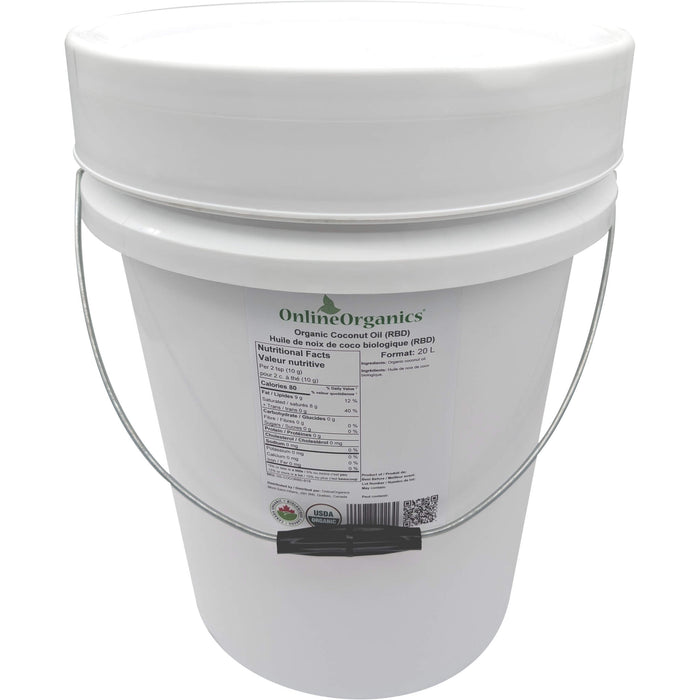
Organic Coconut Oil (RBD)
Specifications (Tap to open):
Category:
Shelf Life:
Country of Origin:
Allergen Information (Tap to open):
We take your health and safety very seriously. If you have any allergen inquiries please Contact Us.
If an allergen is present in the product, it will be clearly declared in the ingredients.
"May Contain" statement NEW FOR 2025 (Progressive rollout):
- In 2025 we will be progressively updating our labels and product pictures with our new label that now include a "May Contain" statement.
- The Canadian Food Inspection Agency (CFIA) dictates that "Cross-contamination statements may be declared by food manufacturers and importers".
- That said, we hold ourselves to much higher standards than the CFIA and Health Canada rules oblige. Most companies do not and you will only rarely see "May Contain" statements.
- If there is a remote chance that there might be cross-contamination of a priority allergen, we will declare it on the product label in the form of a "May Contain" statement.
- A "May Contain" statement does not mean that the allergen is present in the product, it is simple a precautionary measure we take to stay the most transparent possible.
- If an allergen is present in the product, it will be clearly declared in the ingredients.
- For example our Quebec made flours come from a mill that makes both oat and wheat flours. Since both allergens are present in the mill we automatically declare the possibility of cross-contamination even if all precautionary measures are taken.
- Only priority allergens are declared in the "May Contain" statement, which are:
- Cereals & Grains: Triticale, Barley, Oats, Rye, Wheat.
- Tree Nuts: Almonds, Brazil Nuts, Cashews, Hazelnuts, Macadamia Nuts, Pecans, Pine Nuts, Pistachios, Walnuts.
- Peanuts
- Sesame
- Eggs
- Milk
- Soy
- Mustard
- Fish
- Seafood: Crustaceans, Molluscs.
- Sulphites
- Priority allergens are decided by government agencies and health boards. To read more on the subject see "Common food allergens - Priority allergens" published by the CFIA.
- Full CFIA cross-contamination statement explanation "Food allergen cross-contamination (or precautionary) statements".





Our organic coconut oil (RBD) is perfect for many uses. This food-grade oil is used by our clients for cooking, hair products, soapmaking and much more! Ideal for high temperature cooking as an alternative to cheap vegetable and canola oil. It's rich in medium-chain fatty acids (MCFA's), which are, in great part, comprised of Caprylic acid, Lauric acid and Capric acid.
Coconut oil is soothing for the skin and is also excellent as an after shower hair oil.
Numerous clients also use our organic coconut oil to make hydrating soap.
What is the difference between "RBD" and "Virgin" coconut oil?
- RBD is an acronym, which stands for Refined, Bleached and Deodorized.
- As the organic standard prescribes there is no use of chemical bleach or any other artificial chemical for that matter used during the process.
- "RBD" coconut oil is dry steamed to deodorize while being carefully monitored to stay under 180 degrees Celsius. This neutralizes the majority of the coconut taste and smell making ideal for cooking and frying. This is not does not make the product inferior in any way.
- "Virgin" coconut oil goes through the same extraction process but is not dry steamed. This makes it a more natural and pure form of coconut oil. It has a strong coconut taste and smell to it.
What the difference between coconut oil, coconut butter, coconut cream and coconut milk?
- Coconut oil is a fat made from pressed coconut meat. It contains about 99% fat and not much of anything else.
- Coconut butter (70% fat) is made with just shredded coconut that has been blended into a paste. Just like our other nut butters it only contains one ingredient.
- Coconut cream is made by simmering coconut meat in water, The water then separates into a creamy, thick layer and a thin, more watery layer. The thick layer is packaged as coconut cream (25.4-37.3% fat), and the thinner liquid is labeled as coconut milk (12.7-25.3% fat). It contains much of the nutrients found in coconut meat.
How do you open the wholesale pails?
- This is actually a popular question. You can click on the link here to access our instructions. The bucket opener tool is a plus if you are opening dozens, but for just a couple a box cutter is enough.
General Storage Tips:






